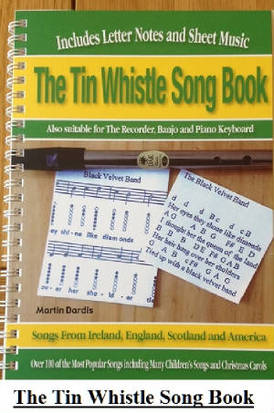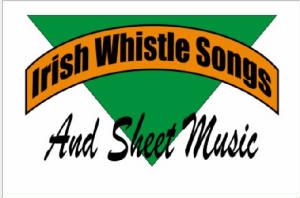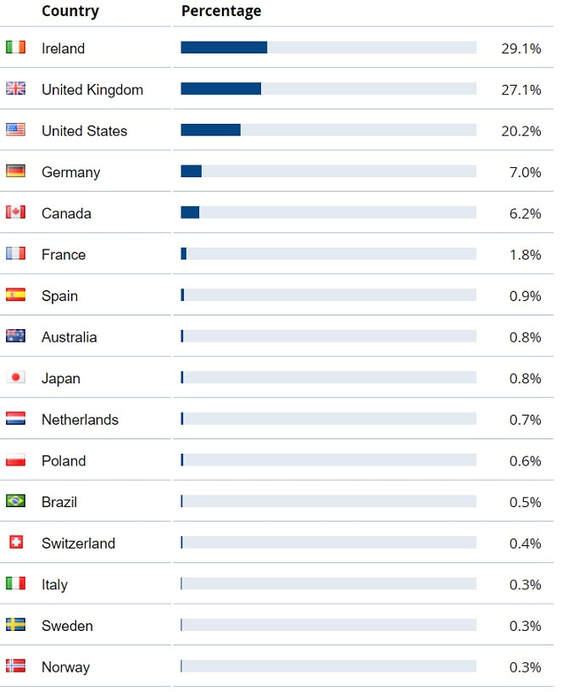Irish Folk Songs Sheet Music & Tin Whistle NOTES Page Two
Sheet Music For Irish Folk Songs in the tin whistle format. About half of these songs now have a youtube video to help you learn the song. When you see the + sign, this means there's a video with the song.
|
The Night Visiting Song
Luke Kelly / Dubliners +Video Ninety Miles From Dublin Christy Moore + Video My Lovely Rose Of Clare Paddy Reilly + Video My Old Man Said Follow The Van Marie Lloyd My Lagan Love Traditional / Celtic Woman The Marino Waltz Noreen Bawn Neil McBride / Bridie Gallagher Maggie Trad. Foster And Allen. Including Banjo Tab The Mountains Of Mourne Percy French Murshin Durkin Trad. Dubliners / J.McEvoy Mo Ghile Mear My Irish Molly Trad. + Banjo tab Nancy Whiskey Trad. The Pogues / + Video, Banjo Tab The Old Woman From Wexford Trad. The Clancy Brothers The Old Man Phil Coulter / The Furey Brothers The Orange Lily O The Old Bog Road Teresa Brayton / J. McEvoy The Patriot Game D. Behan. + Video Peggy Gordon Trad. Scottish / Luke Kelly Paddy's Green Shamrock Shore Trad The Rattlin' Bog Trad. + Video The Red Rose Cafe Roddy McCorley Ethna Carbury + Video Spancil Hill M. Considine. + Video The Spanish Lady Frank Heart + Video The Star Of The County Down + Video The Green Fields Of France Eric Bogle The Rare Old Times Pete St. John. + Video The Galway Shawl + Banjo Tab / Video The Wearing Of The Green The Wind That Shakes The Barley Weile Waile + Video Wrap The Green Flag 'Round Me The Voyage Johnny Duhan / Christy Moore The Three Flowers Norman G Reddin Tipperary So Far Away The Skye Boat Song Harold Boulton / Scottish The Water Is Wide Trad. L. Clancy + Video Whiskey You're The Devil History Of The Tin Whistle
Whistles of various kinds can be found in many countries around the world, from the old clay whistles of bygone days to the plastic tin whistle of today. I Ireland the first reference to the whistle goes back to the 6th century with many references to them in old Irish literature. There are remains of the old bone whistle which was found in Christchurch and it dates back to the 13 century. It was made of bird bone. The most common kind of whistle that's used today is the tin whistle. It became very popular in Britain and France in the 17th century where it was used to play classical music. It was used in orchestras up until the 19th century and had keys and not holes as today. The Clarke whistle which is made in England was the most popular brand until the 1970s in Ireland. In 1978 a new kind of tin whistle appeared in Ireland. It was made by Feadóg. Most are actually made of brass and not tin. The main reason why the tin whistle is so popular in Ireland is because it's taught in primary schools in Ireland. This is to get children interested in learning an instrument and hopefully progress from the humble whistle to a more complex musical instrument. Another reason it's taught is because it's a very inexpensive way to learn music. You can purchase a tin whistle for €5.00 for starting off with. Today all whistles come with a plastic mouthpiece which was invented by the English made Generation. This company still produce the widest range of whistles in different keys. [ Don't forget about my tin whistle song book on sale here on the site ] The Waltons company also produce a wide variety of whistles that produce different tones by changing the bore. American also made a wide variety of them, the Susato Company are famous for making the plastic whistle which is a bit more expensive. [ It's The One I Use ] They make a beautiful sweet tone and have less of a rasp when played. They are now becoming very popular at sessions in Ireland. The most common tin whistle is set in the key of D. when you buy one you'll get a chart showing what holes make each note played and which holes co cover. This chart is called the chromatic scale and it's is only by using half covered holes that a player can play the chromatic scale. While playing the D whistle you can get C natural without half-covering holes. The scale of G Major can also be played on the D whistle. An accomplished player can produce a range of complex forms of ornamentation on the tin whistle in a way that's very similar to playing the flute. |
Sam Hall
Trad. + Video Steal Away Phil Coulter. + Video Sally MacLennane The Pogues The Streets Of London Ralph McTell Shenandoah Somewhere Over The Rainbow Red River Valley + Video Rebel Tunes + Video / Wrap The Green Flag Red Haired Mary Take Me Home To Mayo The Rare Old Mountain Dew The Rising Of The Moon Leo Casey / Clancy Bros / + Video School Days Over The Sash Seven Drunken Nights The Dubliners She Moved Through The Fair Trad. Scotland The Brave Scarborough Fair Traditional English Folk Scots Wha Hae Slievenamon C. J. Kickham Snowy Breasted Pearl The Streets Of New York Liam Reilly / The Wolfe Tones The Sam Song The Irish Brigade A Song For Ireland Phil and June Colclough + Video Sonny's Dream Skibbereen Letter notes only. + Video This Old Man + Video This Story I Tell You Is True J.Reidy / Annemarie O'Riordan and T.R.Dallas Tom Williams The Unicorn Song The Irish Rovers When The Saints Go Marching In + Video The West Awake Ye Jacobites By Name Will The Circle Be Unbroken + Video Whiskey On A Sunday Working Man Willy O'Winsbury Wild Flower Of The Laune Wilhelmus National Anthem Of The Netherlands The Yellow Rose Of Texas Waltzing Matilda Puff The Magic Dragon included Famous Players In Ireland.
Paddy Maloney from The Chieftains has been playing whistles for 50 years. Paddy also plays the uilleann pipes where the fingering is the same. The band started playing in Dublin in '62 and are still playing the traditional tunes and song today, not bad going for playing a little piece of tin pipe. Finbar Furey. Here's another famous whistle player who also started out in the early 60's with the help of his father Ted. His most famous composition is The Lonesome Boatman which he plays on the low whistle, again he's another whistler who plays the uilleann pipes. Noel Nagle. Noel has being playing with The Wolfe Tones for 49 years. Although the 'tones are more known for ballads Noel is well able to play tunes. He also played the pipes but they were stolen a few years ago and sticks to mostly low whistles nowadays Davy Spillane. Born 1959 was an uilleann piper before he embraced the low whistles. Not only is Davy proficient in traditional music but also in jazz and classical music. Dave also makes pipes, a trade he learned from Johnny Burke from Wicklow. He played the low whistle and pipes while he was with Moving Hearts. This was one of the first times the pipes were used outside trad. music. Andera Corr introduced the tin whistle into pop music in the 1990s. The Corrs started out playing the traditional music before branching out into popular music. They had the No 1 and No. 2 albums in the U.K. charts at the same time.Many of the tracks on their albums include tin whistle. Tommy Makem from Keady Co. Armagh played 5 string banjo and the tin whistle. Tommy joined The Clancy Brothers in the early 50's in America. Their first album ''The Rising Of The Moon'' was a big success and this was the first time the tin whistle was used on a whole album. Vincent Broderick who was born 1920 in Loughrea Co. Galway. Vincent learned to play from listening to his mother. He started at the age of 12. He joined the famous Kincora Ceile Band. In 1951 he moved to Dublin and founded the Eamonn Ceannt Ceile Band. Vincent was also involved in the Dublin Pipers Club and Comhaltas Ceoltoire Eireann. He made two albums of his own and composed almost 100 tunes. Peter Browne, a Dubliner born in '53 plays uilliann pipes and whistles. In the mid 1970's he was a member of the group ''1691'' which was later to become The Bothy Band. He played on the album The Bothy Band Live In Concert in 1976. Peter's tune ''Rathlin Island'' was recorded by Sharon Shannon. Vincent works for R.T.E. and was involved in the making of traditional music programmes including one on Seamus Ennis. Willie Clancy learned how to play the whistle at the age of 5. He was born in 1918 and died in '75. Willie came from Miltown Malbay Co. Clare. He learned his music from Garret Barry and the travelling piper Johnny Doran. He won several competitions including the Oireachtas in the 30's. He earned his living as a carpenter as in those days a fella couldn't make money by being a musician. He moved to London in the early 50's to work and returned to Ireland in 1957. There's a summer school that takes place each year in Miltown Malbay named after him, The Willie Clancy Summer School where some class musicians hold work shops teaching traditional music on many instruments. Johnny Keenan learned to play music from a very early age. Born 1946 he started out with his father, although Johnny played many instruments he was more know as a banjo player. He started on the pipes and then low whistles before becoming one of Ireland's fastest tenor and 5 string players. In his early days he played with Ted and Paul Furey and also with Davy Spillane. In the 70's he was part of the group ''Pavees'' who done a rake of gigs in Slattery's Pub on Caple St Dublin. Slattery's was an early house, it's a place where I spent many's a good day drinking and singing myself. The Pavees group had many players over the years and the line up was constantly changing. George and Paul Furey were members of the band at one point. Johnny done many tors around Europe and America. He passed on it 2000. Example Of Sheet Music Used For Whistles. You'll notice it's different than standard sheet notes. Each note has an image of what notes to keep your fingers over while playing. The black holes is where to place your fingers and the clear parts are not to be covered. The + symbol means you will have to blow a bit harder to get the higher note in the second octave. A sharp # symbol means that the note is too low for the chosen whistle. There are no half covered holes used on the sheet music on this site but you may find them on other sheets music for whistle |
Below is a list of countries around the world where the tin whistle is played, and showing the percentage for each country.
There are many other countries with whistle players, but the one's below is where the tin whistle is most popular. The stats are from Google and from Statcounter and are based upon visitors who come to the website.
There are many other countries with whistle players, but the one's below is where the tin whistle is most popular. The stats are from Google and from Statcounter and are based upon visitors who come to the website.





